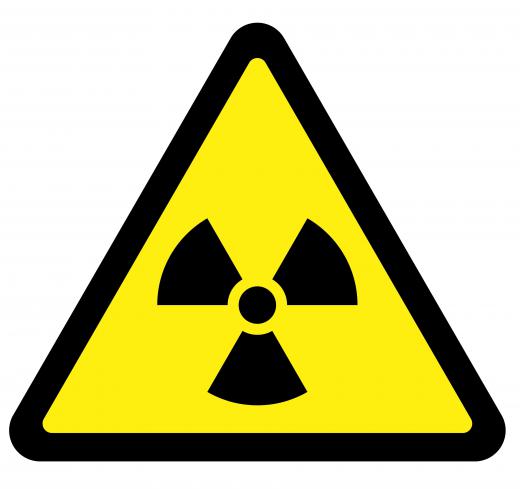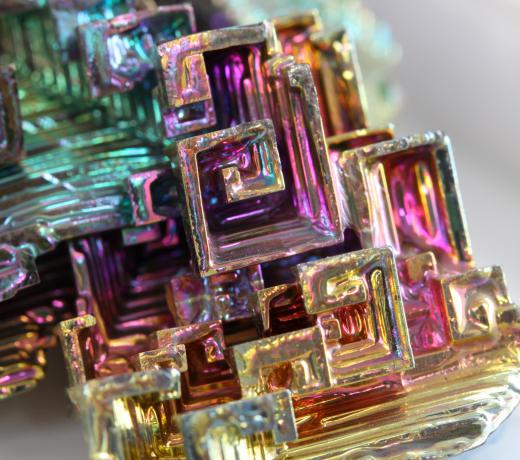What is the Most Radioactive Substance in the World?
A radioactive substance is a substance that is in the process of radioactive decay. This is when the nucleus of the atom is unstable, and so sends off ionizing energy. This makes it reach a lower energy state, and transform.
The idea of which is the most radioactive substance is somewhat problematic in and of itself, because we have to ask what we really mean by most radioactive. There are three main types of ionizing radiation: alpha, beta, and gamma. These are named for the various particles that a radioactive substance may send off. An alpha particle consists of two protons bound together with two neutrons to make something that is the same as the nucleus of helium. A beta particle is either a positron or an electron. And gamma rays are high energy protons, with energy above the 100keV range. There are other types of radiation as well, but these three make up the bulk of observable radiation.

The dangers of these forms of radiation, which play into how we think about which element is the most radioactive, are in many ways influenced by how easy they are to shield. Alpha particles, for example, will bounce off of virtually anything, even a thin sheet of paper, or skin. Beta rays will penetrate the most basic shieldings, but can be stopped by something like aluminum. Gamma rays, on the other hand, will penetrate almost anything, which is why heavy lead shielding is often used in situations where gamma rays may be released.

As a radioactive element transforms, it may undergo various forms of decay along the way. For example, uranium-238 releases an alpha particle to turn into thorium-234, which in turn releases a beta particle to turn into protactinium-234. So one single substance can actually transform into many different radioactive substances over its life-cycle, and in the process can release different types of radioactive energy.

Perhaps the easiest way to assess what substance is the most radioactive is to look at half-lives. The half-life of an element is how long it takes for the element to decay to half its original size. Elements with extremely long half lives may actually appear stable, because it takes them so long to release any energy in the form of radioactive decay. These long-lived elements, such as bismuth, for example, can be treated as essentially non-radioactive, and so are very far from being the most radioactive. Similarly, elements such as radium have half-lives well over 500 years, and so are also not in the running for being the most radioactive.

Elements such as promethium, on the other hand, are dangerous enough to not be safely handled, but not near the most radioactive. As one moves further down the periodic table, one starts to find ever more radioactive substances, such as nobelium and lawrencium. These have half-lives in the minutes, and are quite radioactive.
However, to find the most radioactive substances we have to go to the very ends of the periodic table, to elements ever seen only after being created by humans. Elements such as unbibium at the end of the table, or ununpentium, are among the most radioactive known to man. Ununpentium-287, for example, has a half life of only 32ms. This can be compared to elements such as plutonium-239, which has a half-life of more than 200 years, and so while quite toxic, is nowhere near as radioactive as the heavier elements. Although often called the most radioactive substance on earth, plutonium is in fact quite tame compared to ununpentium, ununtrium, ununoctium, and many others only recently created.
AS FEATURED ON:
AS FEATURED ON:















Discussion Comments
Radium is produced from uranium decay. Where there is uranium, a very tiny amount of radium is formed.
I don't know about the most radioactive one, but the most dangerous ones are those with enough of a long half-life, which keeps them radiating for a long time, and with radiation intensity. Elements with a too short half-life are too unstable to pose a threat for a long time and elements with a too long half-life have too weak an intensity.
A candidate for the most dangerous one is Cobalt 60, with a half-life of 5.2714, years but still very deadly. The idea of doomsday bomb (Cobalt bomb) was based on Cobalt 60. As in five years, the released Cobalt 60 could easily cycle the earth.
Radium is a decay product of Uranium 238. Basically all elements are made in stars or in Uranium 238's case, supernovas.
So, it sounds like you are saying that the shorter the half-life, the more "radioactive" an element is (i.e. the fixed amount of energy to be released during decay is done in a shorter time). So, to define the "most radioactive", shouldn't we be concerned with the total energy released during decay (how much does this vary?), the length of decay and the type of radiation (alpha, beta, gamma)? It would be interesting to see a comparison of a number of isotopes, given all these considerations.
I believe what is generally thought of as most radioactive is which element will kill a human with the least amount or dose.
what is the atomic number of the element from which natural radioactivity starts?
If the radioactivity is the spontaneous process of disintegration, then how does the radium exist in nature?
Post your comments